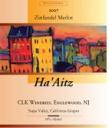Made a trip back up to the Golan Heights today. Once again, feeling like a VIP (I think I can get used to this) I was taken on a private tour of some vineyards and given a tasting of selected wines. I even got to take a trip up a row of vines on a mechanical harvester. WOW!
The work being done in the vineyard is mind boggling and that work is truly reflected in the quality of the offerings. Making wines exclusively grown in the Golan Heights region on its volcanic soils (a result of two volvano eruptions – the most recent a short million years ago), GHW (Golan Heights Winery) grows 22 varietals and produces close to 30 wines. And that does not include the wines made in the Galilee region by its sister winery Galil Mountain.
Starting with the whites I was quite impressed by the quality of the entry level 2007 Golan Sion Creek White. A blended wine that is advertised as semi dry (I guess there must be some residual sugar in there) this wine showed bright & fresh crispness with some citrus notes and a mouth watering acidity. While at the other end of the wine sophistication spectrum, the 2005 Yarden Katzrin Chardonnay is a BIG golden chardonnay with toffee, caramel, nutty aromas and a creamy palate that finishes long with all sorts of complexities.
While on the red side I was introduced to some wines that really got me excited. Of particular interest was the 2003 Yarden Syrah – a big California style Syrah with dark fruit, this concentrated wine with big soft tannins will coat your palate and leave you with a nice long finish. The 2004 Yarden El Rom Cabernet, a single vineyard Cab made from 3 blocks at the El Rom vineyard is a wine that appears to be quite ageworthy, yet it remained somewhat closed and required significant aeration to show its big black fruit, interesting cedar & clove aromas and concentrated flavors. A wine I had been looking forward to trying and was rewarded with was the 2006 Galil Mountain Barbera. Aged for 9 months in French Oak this dark purple wine (surprisingly dark I thought for a Barbera) had enticing aromas of red fruit, and everything forest from pine and bark to bushes and earth. This light bodied, big acid and fresh fruit wine is a FABULOUS food wine. Much more versatile in terms of foods it will pair well with than the more popular Cabs & Merlots.
But getting back to the title of this post, what I found most interesting about my time today (with the warm, patient and very knowledgeable Eran) was the work being done in the vineyard. Not so much the typical leaf trimming, fruit dropping, etc – but the technology. There may be a few people left who still think making wine is as simple as picking some grapes, stomping them in a tub and waiting for the natural yeasts to turn the sugars into alcohol. But boy is there a LOT more going on in the high tech haven holy land winery. The good folks at the GHW measure the weather on a second by second basis with a sophisticated weather monitoring station in each vineyard (often times more than one per vineyard).
Included in this high tech gizmo is wind monitoring, both speed & direction, precipitation measuring, dampness & humidity checking and I’m sure all kinds of other cool stuff I can not remember right now at 2:50AM. All wrapped up in a completely self sufficient solar station that sends the data back to the winery for analysis.
Now how’s that for cool high tech vineyard monitoring stuff!?!?! Does it make a difference in the quality of the wine? You are just gonna have to go pick up a bottle of Yarden, Golan, Gamla or Galil wine and find out for yourself…
Happy Golan Heights (and Galilee) wine region(s) wine tasting!
WTG








